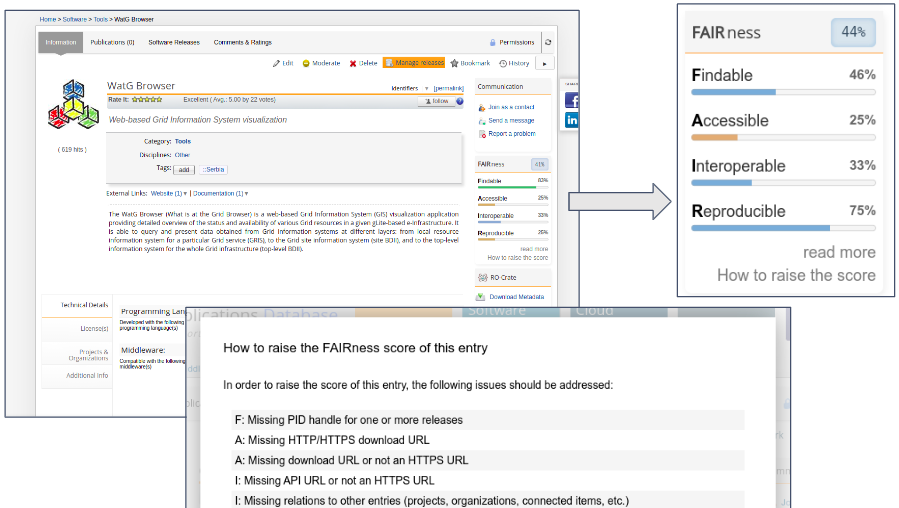FAIRness score
FAIR principles
FAIR stands for Findability, Accessibility, Interoperability, and Reusability and encompases a set of self-described guiding principles which emphasize machine-actionability, enhancing the ability of machines to automatically find and use data. The initial set of FAIR principles was focused towards scholarly data, however, the need to apply these principles to research software as well was quickly recognized, leading to the creation of the FAIR Principles for Research Software (FAIR4RS Principles) by the FAIR4RS RDA working group

The EGI Application Database applies the individual rules of these principles against the metadata of registered research software and computes a score for each principle. The overall score is the average of these individual scores. Entries owners in the AppDB are provided with hints in order to increase the score, by adding optional yet helpful metadata. It should be noted that the scoring algorithm is a an adaptation of the FAIR4RS principles for the needs of a particular platform and should not be viewed as an absolute, but rather as a way to help software maintainers improve metadata quality
Implementation
For those interested in implementation details, the algorithm that computes the scores is written in PL/pgSQL and applies the following mappings
- F: The software, and its associated metadata, should be easy to find for both humans and machines.
- F1. Software is assigned a globally unique and persistent identifier.
- F1.1. Different components of the software must be assigned distinct identifiers representing different levels of granularity.
- The entry has a HANDLE.NET PID
- F1.2. Different versions of the same software must be assigned distinct identifiers.
- Each software release of virtual appliance version of the entry has a HANDLE.NET PID
- F1.1. Different components of the software must be assigned distinct identifiers representing different levels of granularity.
- F1. Software is assigned a globally unique and persistent identifier.
- F2. Software is described with rich metadata.
- The entry has metadata for the following items, at the least: license, description, contacts
- F3. Metadata clearly and explicitly include the identifier of the software they describe.
- The entry has at least one canonical name (cname) assigned, which may be used in a canonical URL
- F4. Metadata are FAIR and are searchable and indexable.
- The entry is accessible over the OAI-PMH interface and the REST API RO-Crate extension
- A: The software, and its metadata, must be retrievable via standardized protocols.
- A1. Software is retrievable by its identifier using a standardized communications protocol.
- A1.1. The protocol is open, free, and universally implementable.
- The entry has an HTTP/HTTPS download URL provided in its links section
- A1.2. The protocol allows for an authentication and authorization procedure, where necessary.
- The entry has an HTTPS (not plain HTTP) download URL provided in its links section
- A1.1. The protocol is open, free, and universally implementable.
- A2. Metadata are accessible, even when the software is no longer available.
- The entry is accessibile from the AppDB portal (not deleted or moderated)
- A1. Software is retrievable by its identifier using a standardized communications protocol.
- I: The software interoperates with other software through exchanging data and/or metadata, and/or through interaction via application programming interfaces (APIs).
- I1. Software reads, writes and exchanges data in a way that meets domain-relevant community standards.
- The entry has an HTTPS (not plain HTTP) API URL in its links section
- I2. Software includes qualified references to other objects.
- The entry is associated with other entities in its connected items, projects, or organizations sections
- The entry provides an HTTP/HTTPS contextualization URL in tis links section
- I1. Software reads, writes and exchanges data in a way that meets domain-relevant community standards.
- R: The software is both usable (it can be executed) and reusable (it can be understood, modified, built upon, or incorporated into other software).
- R1. Software is described with a plurality of accurate and relevant attributes.
- R1.1. Software must have a clear and accessible license.
- The entry has at least one license in its licenses section
- R1.2. Software is associated with detailed provenance.
- The entry has one or more people in its contacts section
- The entry has data in its programming languages section
- The entry has data in its supported operating systems section
- The entry has data in its supported operating systems section
- R1.1. Software must have a clear and accessible license.
- R2. Software includes qualified references to other software.
- The entry is associated with other AppDB entries in its connected items section
- R3. Software meets domain-relevant community standards.
- TODO: integration with FAIRsharing.org
- R1. Software is described with a plurality of accurate and relevant attributes.
NOTE: The mapping above stands for version 8.0.0 of the AppDB portal and may be subject to changes and improvements in future releases, in which case this documentation, as well as the hints provided in the portal itself will be updated, along with the FAIR scores, where applicable